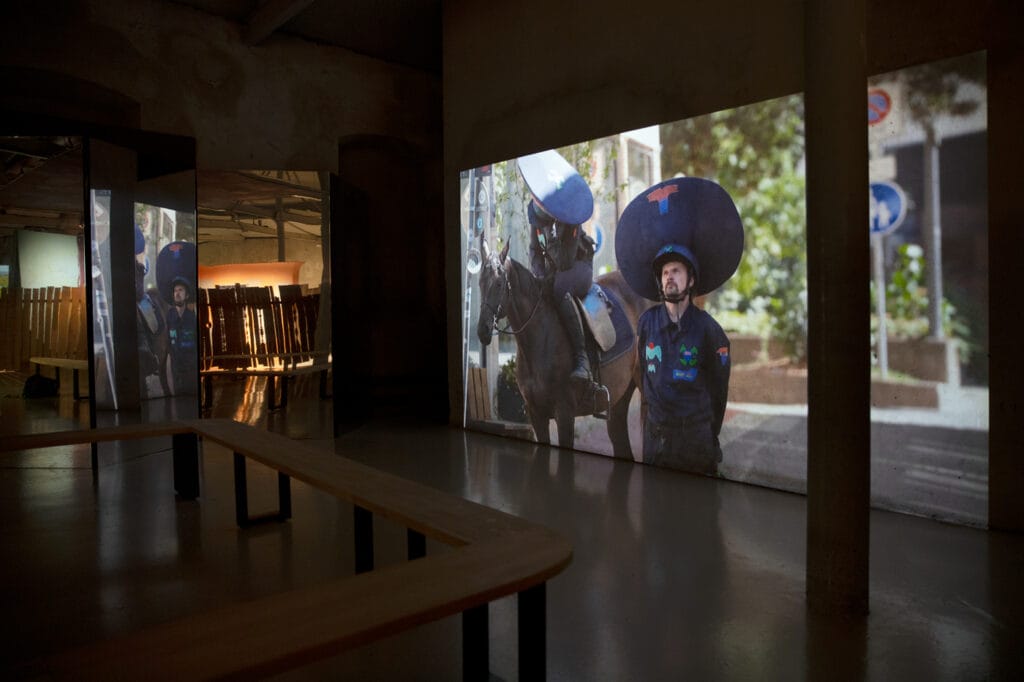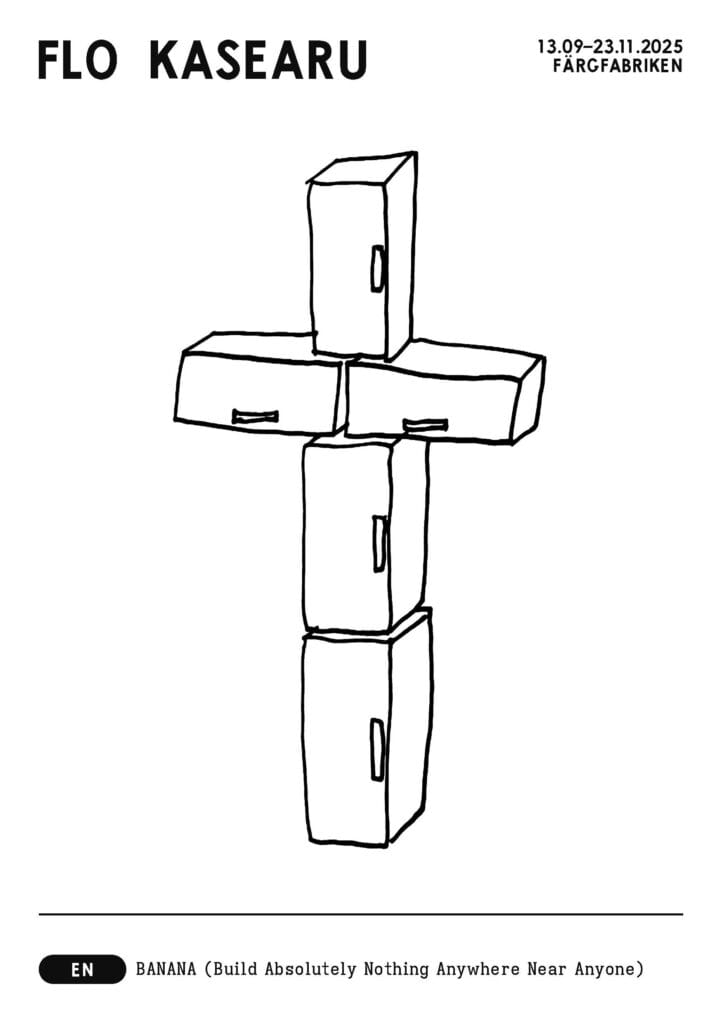Flo Kasearu – BANANA (Build Absolutely Nothing Anywhere Near Anyone)
Solo exhibition, Main hall
Curator: Anna-Karin Wulgué
Introductions and guided tours are included in the entrance fee daily, read more here.
BANANA(Build Absolutely Nothing Anywhere Near Anyone) marks the first large-scale presentation of Kasearu in Sweden. In the exhibition, Flo Kasearu explores everyday life when faced with change—and the fears that follow. With a distinctive blend of irony, humor, and absurd logic, Kasearu invites us to reflection upon humanity’s resistance to the unknown, while probing perspectives on safety, control and belonging.
What if a high-rise is planned in your neighborhood? What if all your friends move away? What if public space keeps shrinking? Should I put up a fence around what’s mine? What if my house is swept away or the internet cable is cut again? What if I no longer recognize my surroundings, and everything just feels completely BANANA?!

Kasearu raises questions about how urban development and green energy initiatives transform landscapes. The exhibition features both earlier works and new productions—paintings, drawings, installations and films—weaving together the personal and the societal. The tension between private life and the surrounding community has been central to Kasearu’s practice from the very beginning. She has worked across a wide range of materials and techniques, creating works for both exhibitions and public spaces, while also running the site-specific work Flo Kasearu House Museum in her own home in Tallinn.

At Färgfabriken, visitors are invited into an artistic exploration of the emotions that arise when the familiar is unsettled—when a new construction project is planned in the neighborhood, when old houses are demolished, or when wind turbines rise on the horizon. Symbols of the future, sustainability, and progress simultaneously become projections of anxiety, loss, and conflict.
The exhibition is presented in collaboration with Kai Art Center in Tallinn, with support from the Estonian Ministry of Culture.
About the artist

Flo Kasearu has studied painting and art at the Estonian Academy of Arts, as well as at Rebecca Horn’s multimedia studio at the Berlin University of the Arts. In 2013, she opened her own house-museum in Tallinn. Kasearu has participated in the Gwangju Biennale in South Korea, the Performa Festival in New York and received several awards such as the Estonian State Cultural Award (2021). In addition to private collections, her works can be found at the Estonian Art Museum, Tartu Art Museum, Kiasma, the European Central Bank and the Flo Kasearus House Museum.
Read more
Three questions to Flo Kasearu
Can you tell us something about the idea behind the exhibtion, and what came first, BANANA or “Build Absolutely Nothing Anywhere Near Anyone”?
Build Absolutely Nothing Anywhere Near Anyone came first. Right now, I’m involved in several development projects in different places: at my home, my country house, and at Kai, where the BANANA exhibition is currently on display.
The idea started when the courtyard next to my home was purchased by a company that began constructing a massive building right beside my house. The neighborhood I live in is quite green, filled with small, old houses — and suddenly, this modern, oversized building with huge windows directly overlooking my backyard, was being built.
The title also references the development of wind turbine parks near my countryside home. Plans are being made for a wind farm just one kilometer away. This is part of a wider shift happening across Estonia in rural areas, where energy production is moving toward greener, more modern technologies.
The concept BANANA was developed for the exhibition shown at Kai Art Center in Tallinn 2025. Kai is located in the middle of a former industiral area, just like Färgfabriken, a place that is now a rapidly developing real estate area. The entire district around Kai has transformed from nothing to fully built-up in just five years, with constant new construction taking place.
What does irony mean to you and your artistic work?
I like it when my artwork isn’t dead serious. Life is serious — and so is art, of course — but I enjoy incorporating irony as well. Not as a dominant element, but as one of several layers within the work.
For me, the best artworks are those with many layers: political, social, aesthetic — and also ironic. The more layers a piece has, the more interesting it becomes, because people experience it differently. Some people might not like irony at all, and they might instead approach the work from a purely political or aesthetic perspective. Others might connect with the ironic aspect.
The first thing we meet in the exhibition is a fence. What is the meaning of the fence for you as an artist?
The fence is a part of the concept – Build Absolutely Nothing Anywhere Near Anyone. Normally, when people go to an art gallery, they expect to get close to the works, to view every detail. But BANANA deals with the idea of space — especially the tension between private and public space — and how accessible space is becoming more and more limited as everything is increasingly privatized.
The fence reflects that. It creates the narrative about the dynamics of inclusion and exclusion that define contemporary development and the complexities of the land use. The fence creates a kind of “forbidden” zone, like a holy backyard — something I connect to personally. That how different developments and changes are coming closer and closer to my private space and how it makes me feel.
I don’t like fences because they’re usually quite ugly, and they function as border and somthing thats trying to block me from going somewhere. When the developer next to my house tore down my old fence to put up a new one, I decided to keep all the pieces. The fence was around 100 years old, just like my house, and as an artist, I like reusing materials.
Over time, the fence became a conceptual material to work with. I started to like it because it had literally marked the boundary between the neighbour and my territory. But I didn’t want to reuse the fence just as a fence. Instead I started to play around with it and carve ornaments into the wood to make it more beautiful and personal, to update the fence to fit the art exhibition.
And fence is also a defence.
Exhibition folder

Contact
Partners
The exhibition is a collaboration with the Kai Art Center in Tallinn, with support from the Estonian Ministry of Culture.

